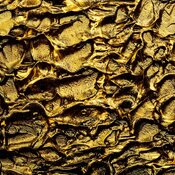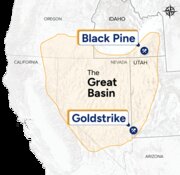Doug Groh: We remain very positive on the dynamics of the gold market and are even more excited about the prospects for gold mining companies. We really are not taking a different path, other than sticking by our positions and seeking out good opportunities.
The market has been missing the tremendous margins gold mining companies have right now, despite rising production costs. The average gold price is up more than the cost increase over the past year, which has allowed for margin expansion throughout the industry.
TGR: The Tocqueville Gold Fund received the 2012 Lipper Fund Award for the best fund in the precious metal category for the three-year period ending Dec. 31, 2011. Congratulations. What is the fund's current value and how did it perform in 2011 compared with the Philadelphia Gold and Silver Index?
DG: As of March 28, the Gold Fund was at $2.24 billion and the net asset value per share was $69.88.
As far as performance goes, as of Dec. 31, 2011, we were down 15.85%, while the Philadelphia Gold Index was down 19.16%. So, we did a little better.
TGR: What do you at Tocqueville expect of the gold market in 2012?
DG: We are very optimistic. From our perspective, gold bullion is still very much under-owned and gold mining equities are very much under-appreciated and misunderstood.
There is a lot of risk aversion going on. Equity investors worry about operating costs and about the volatility in gold equities. They are concerned that the gold price has peaked.
These concerns ignore the margin expansion in the gold mining sector. They ignore that gold bullion is under-owned. They ignore that central banks have been significant buyers of gold for two years and will most likely continue to buy gold to diversify their reserves away from the U.S. dollar.
While gold is susceptible to movements in interest rates and in the U.S. dollar, the potential for a structural shift in people's interest in gold is very strong. In particular, demand in India and China has a long way to grow. Gold is a very important currency in the Asian market.
It is hard to say what the gold price will be at any given point in time. I still think it is headed to the $2,000/ounce mark in the next 12 months. But that is not the endgame for gold. It still has a long way to go.
TGR: When we talked in June 2011, gold had been outperforming equities for five months. It's 10 months later; did you imagine then that equities would still be lagging the performance of gold? How are you and your fund managers adjusting to that?
DG: I did not think gold equities would underperform as much as they have. I attribute it to risk aversion in the equity markets. Gold stocks are equities first and foremost. In addition, investors have very high expectations for gold mining equities and the companies have disappointed the market's expectations.
We are holding to our positions. This is more of a stock picker's market than for general exposure to gold mining equities. While the gold mining exchange-traded funds may serve a purpose, one can add value by actively managing a gold equity portfolio. That requires more due diligence and an understanding of what the companies are trying to do and what they have accomplished.
We focus on companies that are well financed and well managed, companies with track records for building shareholder value and that, importantly, have a very good asset base. We want to know: What resource is the company working from? What is it developing?
TGR: Does stock picking become harder when macro drivers move share prices more than the companies' fundamentals?
DG: In some regards it requires more patience. Stock picking is difficult. You have to look at the higher quality companies. Understand their strategies. Understand management's vision. It demands that you appreciate the assets they are working with. That requires talking with the companies, visiting their assets, observing what they are doing with those assets and staying in touch with their progress.
TGR: Last June, the Tocqueville Gold Fund was 35% vested in small-cap explorers and developers. Is that still the case or are you leaning more heavily toward companies generating cash flow and perhaps offering a dividend?
DG: We are shifting out of the junior explorers to some extent. We are not necessarily trading out of our positions, but our positions are now that much more advanced in terms of the companies' lifecycles. Thus, a greater percentage of our portfolio now is in developing or producing companies as opposed to explorers and discoverers. It is a natural evolution.
And, some of the larger companies have done a bit better than some of the smaller names. So, we have a percentage shift to the larger caps.
TGR: Are you more selective now, given that the price environment among gold equities has created so many bargains?
DG: It is interesting that, even though these companies produce the same product, their valuations are all over the place. Companies are valued differently for different reasons; they are getting different discounts for different reasons.
This means investors have a lot to consider. They have to understand each company and its situation: its capital needs, cash flow, capital structure, strategy and where it operates.
TGR: What advice would you give retail investors in today's environment?
DG: Investors have lots of choices for exposure to the gold mining sector. If they have the network and ability to gather and assess a lot of information, they can invest on their own. More power to them, they should.
An index fund is another approach. A third way is to invest in a diversified portfolio of well-known names that is covered by various investment banks. Both of these approaches can keep surprises to a minimum.
TGR: Are institutional investors like Tocqueville Asset Management more likely to set the terms of private placements these days?
DG: Compared with a couple of years ago, yes. Investors can have a greater input into how a financing is structured these days. Companies need capital and the markets are not quite as friendly to general equity issuance. That means management has to be more creative with financing projects. There is more of an open discussion between investors and management.
TGR: Where do you see pockets of investment opportunity in the gold space? You seem to be leaning heavily on royalty plays.
DG: The royalty companies have a very interesting model. They are diversified and have less asset exposure and capital commitment than some of the mining companies. I think this is a very profitable model in this environment.
TGR: What are some other opportunities for investors?
DG: Detour Gold Corp. (DGC:TSX) and Bear Creek Mining Corp. (BCM:TSX.V) might be considered. In the Yukon, there is ATAC Resources Ltd. (ATC:TSX.V).
Gold Resource Corp. (GORO:NYSE.A; GORO:OTCBB; GIH:FSE) is interesting in that it is issuing a gold dividend, which shows that companies are responding to investors' desire for return on shareholder value. Companies are trying to differentiate themselves from gold exchange-traded funds.
I think good opportunities remain for companies developing assets in the right part of the world. That may be West Africa, Mexico, eastern or western Canada, even Alaska.
TGR: Are you concerned about creeping nationalism today, given events in South America, and even more recently in Mali?
DG: Yes, nationalism is a bigger concern today. Nationalism can be expressed in many ways including higher taxes on companies, royalties or participating interests.
Nationalism is not surprising. The industry is very profitable. Jurisdictions recognize that and are trying to capture more of that value for their national needs. But some of those policies are so restrictive that they drive capital and foreign investment away. That is a concern for investors.
TGR: Does that mean you have steered away from certain jurisdictions?
DG: Yes, Venezuela and Bolivia come to mind. Russia presents tremendous opportunity, but we are concerned about governance and about how business is conducted there.
The Middle East and North Africa have interesting potential, but again, there are concerns.
TGR: Let us look at some of the positions in your gold fund. Randgold Resources Ltd. (GOLD:NASDAQ) has significant exposure to Mali, where a recent coup is creating instability. What is your current approach to Randgold?
DG: We are taking a wait-and-see approach; we have not sold. Actually, I see this as a buy opportunity. Randgold believes the situation is more politically and socially complex than the media may be portraying.
We believe that in a relatively short period of time the political instability in Mali will resolve itself. Randgold continues to operate its mines as it did during other political conflicts in the region. For example, during a civil war in Côte d'Ivoire, Randgold held on to its property and built a mine during the government transition.
TGR: You also have exposure to West Africa through Abzu Gold Ltd. (ABS:TSX.V), which owns the Nangodi gold play in Ghana. Initial results from the company's current drill program seem to indicate the potential for open-pit gold mining.
DG: Abzu has done initial exploration and drilling. It seems to be on to a deposit that deserves more attention. My sense is that the company has limited capital and will need to reassess its position in terms of making the most of its land position and resource base in Ghana.
TGR: You continue to hold a fairly large position in Osisko Mining Corp. (OSK:TSX). Now you have a position in Detour Gold, a similar story in the same part of the world. What can you tell us about Detour Gold?
DG: It is very similar to Osisko, in that as both companies build and derisk their projects, their market valuations should rise as the market appreciates their efforts. Both are meeting their goals and realizing success.
TGR: Osisko has been in production a little less than a year. Are you satisfied with its results?
DG: Basically, yes. We understand the design and engineering challenges a company can run into when it starts up a mine. Our understanding is that the deposit is performing better than perhaps was expected. The grades and recoveries are good. Osisko is producing gold, perhaps not quite at the level originally expected, but we can work with that. In the end, we think Osisko will have a very successful operation. Given the gold price and its production costs, the company should have this mine paid off relatively quickly.
We might be a little disappointed that the market is not giving Osisko the valuation we feel it deserves. I am not sure why. It is in a favorable jurisdiction. Its costs are not out of line. It is slowly meeting its targets. Maybe what concerns investors is that the ramp-up is not happening soon enough. But in time, Osisko should deliver the project as it intended.
TGR: Do you expect Detour Gold to have similar success?
DG: We anticipate that. Detour Gold will probably run up against similar issues. The project may not get the expected throughput initially, or recoveries might be a bit off. But management will make the necessary adjustments. In time, I anticipate management will deliver on its plan, with the typical hiccups along the way.
TGR: You have exposure to silver production in Mexico. Are silver and gold producers takeover targets?
DG: I suppose every company could be considered a target.
We see relatively small deposits with great potential in Mexico. Large producers are looking for deposits that can be scaled up. Witness Goldcorp Inc.'s (G:TSX; GG:NYSE) acquisition at Peñasquito some years ago. Or the numerous property/company transactions that have taken place since.
Scorpio Gold Corp. (SGN:TSX.V), Levon Resources Ltd. and Gold Resource are operating now. Some are generating cash flow. Yet, they have not fully explored their properties. There is significant potential to identify value where it is yet unrealized or unrecognized.
TGR: Overall, you seem pretty optimistic.
DG: You know a lot of these stocks performed quite well years ago when the gold and silver prices were much lower. Companies were raising capital to build out their mines or expand operations. In one regard, company valuations were higher than they are now. That makes me ask, what is wrong with a market that does not recognize companies like Osisko and Detour that we believe will deliver?
I think the outlook is very good for precious metals and, in particular, for gold mining equities. Maybe it is time to turn the corner into Q212 and think about a new story, to let gold mining equities come into their own as the year progresses.
TGR: Doug, thank you for your time and your insights.
Doug Groh has 25 years of investment experience. Before joining Tocqueville in 2003, he was director of investment research at Grove Capital from 2001–2003. Between 1992 and 2001, as a senior sell-side analyst for JP Morgan and Merrill Lynch, he was recognized as a ranked analyst by Institutional Investor Magazine and The Wall Street Journal for his coverage of basic material stocks in the non-ferrous metals, chemicals and paper and packaging industries. He began his career as a mining analyst and worked as a precious metals portfolio manager at U.S. Global Investors and American Express Financial Advisors in the 1980s and early 1990s. He holds a masters in energy and mineral resources from the University of Texas at Austin and a Bachelor of Science degree in geology/geophysics from the University of Wisconsin–Madison.
Want to read more exclusive Gold Report interviews like this? Sign up for our free e-newsletter, and you'll learn when new articles have been published. To see a list of recent interviews with industry analysts and commentators, visit our Exclusive Interviews page.
DISCLOSURE:
1) Brian Sylvester of The Gold Report conducted this interview. He personally and/or his family own shares of the following companies mentioned in this interview: None.
2) The following companies mentioned in the interview are sponsors of The Gold Report: Detour Gold Corp., Abzu Gold Ltd., Goldcorp Inc., Scorpio Mining Corp. Streetwise Reports does not accept stock in exchange for services.
3) Doug Groh: This article reflects my views as of the date or dates cited and may change at any time. The information should not be construed as investment advice. No representation is made, nor is there any guarantee that any projection, forecast or opinion will be realized. References to stocks, securities or investments in this writing should not be considered recommendations to buy or sell. Past performance is not a guide to future performance. Securities that are referenced may be held in my personal portfolio or in portfolios managed by Tocqueville or by principals, employees and associates of Tocqueville, and such references should not be deemed as an understanding of any future position, buying or selling, that may be taken by either me or Tocqueville. I personally and/or my family own shares of the following companies mentioned in this interview: Tocqueville Gold Fund. I personally and/or my family are paid by the following companies mentioned in this interview: as an employee of Tocqueville Asset Management. I was not paid by Streetwise Reports for participating in this story.










































